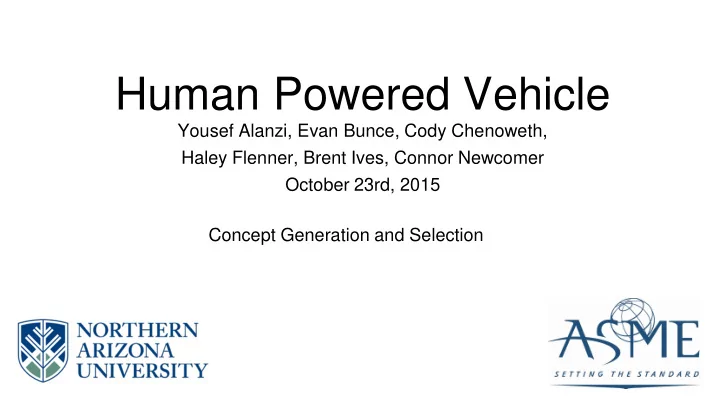

Human Powered Vehicle Yousef Alanzi, Evan Bunce, Cody Chenoweth, Haley Flenner, Brent Ives, Connor Newcomer October 23rd, 2015 Concept Generation and Selection
Overview ● Introduction ● Criteria ● Analytical Hierarchy Matrix ● Relative Weights of Criteria ● Concept Generation ● Decision Matrix ● Project plan ● Conclusion ● References 2
Introduction ● There is a need for safe, efficient, reliable transportation for people in underdeveloped countries ● The goal of this project is to reduce transportation costs by designing and building safe, efficient, and reliable human-powered vehicles ● Design objectives include weight, cost, speed, acceleration, and size ● Constraints include a new design and pure human power ● Current competition vehicles are made of metal alloys or composites, or a mixture of both, with a recumbent riding position and minimal aerodynamic effects 3
Criteria ● Frame ● Fairing ○ Strength ○ Strength ○ Weight ○ Weight ○ Ease of Manufacturing ○ Ease of Manufacturing ○ Aesthetics ○ Aesthetics ○ Cost ○ Cost ○ Durability ○ Durability ● Steering ● Power Input ○ Ease of Use ○ Speed ○ Cost ○ Ease of Manufacturing ○ Ease of Manufacturing ○ Safety ○ Power Input ○ Cost ● Material ● Seating Position ○ Strength ○ Ease of Use ○ Weight ○ Cost ○ Ease of Manufacturing ○ Ease of Manufacturing ○ Power Input ○ 4 Comfort
Analytical Hierarchy Matrix Framing Strength Weight Ease of Manufacturing Aesthetics Cost Durability Strength 1.000 0.200 1.000 9.000 4.000 2.000 Weight 5.000 1.000 9.000 8.000 9.000 3.000 Ease of Manufacturing 1.000 0.111 1.000 9.000 1.000 4.000 Aesthetics 0.111 0.125 0.111 1.000 0.125 0.125 Cost 0.250 0.111 1.000 8.000 1.000 1.000 Durability 0.500 0.333 0.250 8.000 1.000 1.000 Total 7.861 1.881 12.361 43.000 16.125 11.125 5
Relative Weights of Framing Criteria Ease of Strength Weight Aesthetics Cost Durability Overall Manufacturing Strength 0.127 0.106 0.081 0.209 0.248 0.180 0.159 Weight 0.636 0.532 0.728 0.186 0.558 0.270 0.485 Ease of 0.127 0.059 0.081 0.209 0.062 0.360 0.150 Manufacturing Aesthetics 0.014 0.066 0.009 0.023 0.008 0.011 0.022 Cost 0.032 0.059 0.081 0.186 0.062 0.090 0.085 Durability 0.064 0.177 0.020 0.186 0.062 0.090 0.100 6
Concept Generation: Fairing Concept 3 Concept 2 Concept 1 Concept 4 Concept 5 7
Decision Matrix: Fairing Fairing Weight Efficiency Ease of Manufacturing Cost Durability Overall Concept 1 4 3 3 2 3 3.164 Concept 2 4 5 3 2 3 4.132 Concept 3 4 1 3 2 3 2.196 Concept 4 4 2 3 2 3 2.680 Concept 5 4 5 3 2 4 4.200 8
Concept Generation: Power Input Concept 2 Concept 4 Concept 1 Concept 5 9 Concept 3
Decision Matrix: Power Input Ease of Power Input Speed Safety Cost Overall manufacturing Concept 1 3 2 3 3 2.815 Concept 2 5 5 5 5 5.000 Concept 3 2 2 2 4 1.834 Concept 4 3 2 4 2 2.454 Concept 5 1 1 1 0.815 1 10
Concept Generation: Seating Concept 1 Concept 4 Concept 2 Concept 5 Concept 3 11
Decision Matrix: Seating Seating Ease of Use Cost Ease of Manufacturing Comfort Overall Concept 1 5 4 4 3 4.401 Concept 2 3 3 3 4 3.188 Concept 3 1 1 1 1 1.001 Concept 4 4 2 2 5 3.721 Concept 5 2 4 4 5 3.025 12
Concept Generation: Frame Concept 4 Concept 2 Concept 5 Concept 3 13 Concept 1
Decision Matrix: Frame Ease of Frame Strength Weight Aesthetics Cost Durability Overall Manufacturing Concept 1 2 5 4 3 3 2 3.589 Concept 2 4 4 3 5 5 4 4.827 Concept 3 5 1 1 1 1 3 1.812 Concept 4 3 4 2 5 5 4 4.569 Concept 5 1 2 5 1 3 2 2.802 14
Concept Generation: Steering Concept 2 Concept 5 Concept 1 Concept 4 Concept 3 15
Decision Matrix: Steering Steering Ease of use Cost Ease of manufacturing Power input Overall Concept 1 3 1 1 5 2.905 Concept 2 5 3 3 1 3.797 Concept 3 5 4 4 1 4.031 Concept 4 5 4 4 1 4.031 Concept 5 5 4 5 1 4.216 16
Concept Generation: Material www.hobbyking.com www.mountainbike-review.com www.mountainbike-review.com www.endless-sphere.com www.mountainbike-review.com 17
Decision Matrix: Material Ease of Material Strength Weight Aesthetics Cost Durability Overall Manufacturing Steel 5 1 4 1 3 5 3.261 Aluminum 3 3 3 4 3 4 3.372 Carbon 4 5 2 5 1 4 2.859 fiber Fiberglass 2 4 2 2 3 2 3.121 Wood 1 2 5 3 3 1 2.853 18
Updated Project Plan 19
Conclusions ● Strength, weight, efficiency, and ease of manufacturing are among the most important design criteria ● The teardrop fairing design of the Pulaski will be retained ● Foot-pedal power alone will be used to propel the vehicle ● The seat will be one piece and adjustable ● A laterally braced backbone frame will be employed ● Steering will be accomplished with two levers, one on each side of the seat ● The frame material will be aluminum ● The project remains on schedule 20
References • American Society of Mechanical Engineers . n.d. <https://www.asme.org/about-asme>. • Dieter, George. Engineering Design: A Materials and Processing Approach. New York: McGraw-Hill, 1983. 21
Recommend
More recommend